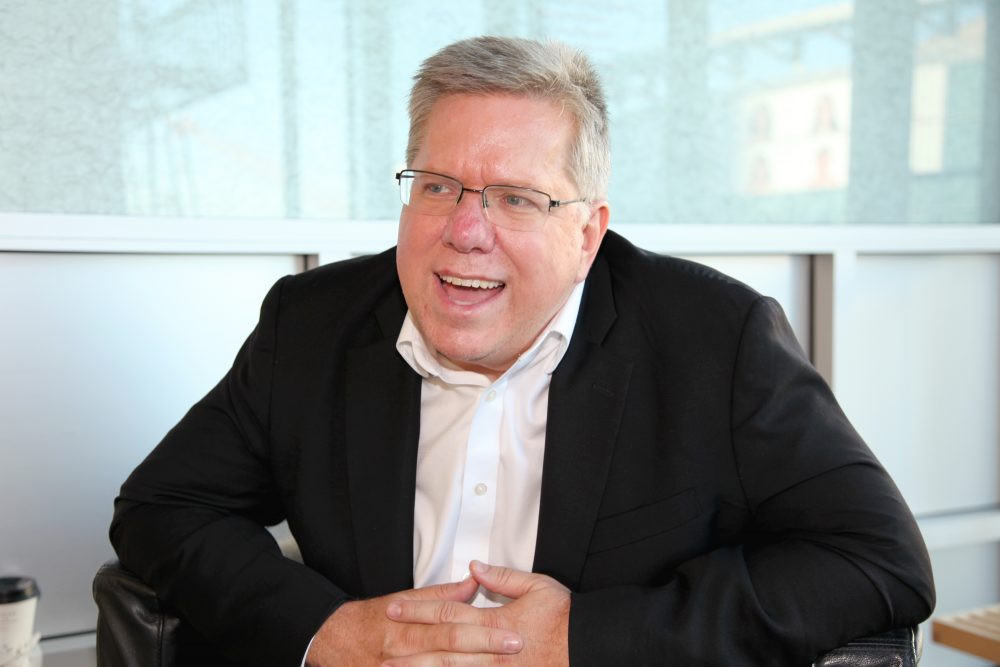
Photo by Aaron Salcido.
Andrew Selee is president of the Migration Policy Institute, former executive vice president at the Woodrow Wilson International Center for Scholars, a columnist for the Mexican newspaper El Universal, and the author of Vanishing Frontiers: The Forces Driving Mexico and the United States Together. Before delivering a Zócalo Public Square lecture titled “Are the U.S. and Mexico Becoming One Country?” at the National Center for the Preservation of Democracy in downtown Los Angeles, he spoke in the green about why he loves Tepoztlán and Copenhagen, why he moved to Tijuana after college, and who he’s rooting for in the World Cup.
How did your interest in Mexico get started?
I traveled to Mexico when I was in college, to study Spanish, and then spent some time in Central America and South America. And I ended up working with immigrant communities in the United States. And so there was a growing interest generally in Latin America. But my real interest in Mexico, specifically, sprung up when I moved to Tijuana after college.
What took you there?
I had been very involved with the YMCA, and there was a great project there working with migrant youth and working with low-income communities on the outskirts of Tijuana. It was the last city in the world I thought I’d move to. I thought I was going to be dancing tango in Buenos Aires, or contemplating the lake in Guatemala. I end up in Tijuana, on the border, and spent five, almost six years living there, and from there never really left Mexico. I came back to the U.S. but the rest of my professional life and a lot of my personal life ended up connected to Mexico in many ways.
Do you have a favorite place in Mexico, that you go back to?
I love Tepoztlán. I think that is probably my favorite place to go in Mexico. It is a beautiful city surrounded by mountains that manages both to be very cosmopolitan for a small town and yet very traditional, and has preserved a traditional essence despite an invasion of Mexico City people and foreigners. San Miguel de Allende is a bit like that, which I enjoy as well. But Mexico City and Tijuana are cities that I love deeply. And I got to know Guadalajara writing my book, and really found that a fascinating city, because Guadalajara is both much more traditional than Mexico City, much more conservative, and at the same time it’s got this tech edge to it, and it’s also got drug-trafficking underneath. So all sorts of currents are happening at the same time.
How did your personal life get shaped by your connection to Mexico?
I moved back to Washington, D.C., where I’d grown up, not because I wanted to get into politics, but because my family was there. And I ended up getting into the policy world. But I also met a woman from Mexico, and not surprisingly our friends were trying to get us together. She had moved to the States a few years earlier. So we’ve really had a binational life. We have children that we’ve tried to raise bilingual and bicultural.
What do you do to unwind?
These days I mostly hang out with my kids. I mostly end up at the zoo or in a park somewhere, or watching a movie with my daughter or taking her to a bookstore. That’s mostly what I do to unwind. At other times I read.
What are you reading for pleasure?
I just read [Mohsin Hamid’s] Exit West. It’s a good novel. And I read Yascha Mounk’s book [The People vs. Democracy: Why Our Freedom Is in Danger and How to Save It], which was quite good. I just read Jonathan Haidt’s book on morality, The Righteous Mind: Why Good People Are Divided By Politics and Religion, which is something that I struggle with, particularly now that I work a lot on immigration: why we have different moral frames, and accepting the fact that we actually do have different moral frames.
Is there another place where you’d like to live?
I love Tepoztlán, so that’s one place. I love Copenhagen—my mother is Danish. A piece of me has always wanted to spend time with my family in Copenhagen. That’s a beautiful place. And part of me would love living in India, too.
Was there a teacher or professor who helped set a course for your career?
My sixth-grade teacher first got me interested in Latin America, Mrs. Dater. She had us study Latin America and Africa; I became fascinated by both. I can’t really say there’s a straight line from there to ending up living in Tijuana or writing this book, but certainly it was the first foundations of curiosity about what lay south of the border. And along the way I had great professors in college who pushed me on this.
Today we got the announcement that the United States, Canada, and Mexico will jointly host the 2026 World Cup. Are you a soccer fan?
I’m not a soccer fan, but I’m a World Cup fan. The same with baseball, I’m a World Series fan more than a baseball fan. But I’ve been following the World Cup bid closely. I’m rooting for Mexico in the World Cup.



